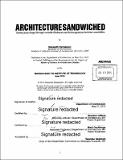| dc.contributor.advisor | Brandon Clifford and Mark Goulthorpe. | en_US |
| dc.contributor.author | Ekmekjian, Nazareth (Nazareth Vahe) | en_US |
| dc.contributor.other | Massachusetts Institute of Technology. Department of Architecture. | en_US |
| dc.date.accessioned | 2015-10-14T15:02:28Z | |
| dc.date.available | 2015-10-14T15:02:28Z | |
| dc.date.copyright | 2015 | en_US |
| dc.date.issued | 2015 | en_US |
| dc.identifier.uri | http://hdl.handle.net/1721.1/99272 | |
| dc.description | Thesis: S.M., Massachusetts Institute of Technology, Department of Architecture, 2015. | en_US |
| dc.description | Cataloged from PDF version of thesis. Page 61 blank. | en_US |
| dc.description | Includes bibliographical references (pages 58-59). | en_US |
| dc.description.abstract | Much of architecture's earliest material palettes and construction methods are often referred to today as legacy materials - those primarily consisting of various types of stone and masonry construction. While these materials are often conceptually thought of as being solid, monolithic, and even homogeneous, in actuality they rely on logics of assembly more akin to contemporary sandwich structures, which are laminar assemblies typically composed of two or more stressed skins and either a solid or cellular core that binds them together. While it is still common to use ancient materials in contemporary architecture, the construction methods and techniques used several hundred years ago are no longer appropriate for today's buildings. This thesis however, argues for a newfound relevance of their influence on contemporary and even future material selections and methods. Specifically, this thesis explores the potentials of composite sandwiches varying in thickness and material in search of architectural possibilities whose structural, formal, and aesthetic implications are a result of tuning multiple influences. Variable thickness is used here as a strategy for enabling a range of architectural and tectonic conditions, all within the same heterogeneous but integrated laminar assemblies. While most commercial products in the realm of composite sandwiches are of uniform thickness in section, this thesis suggests a method for constructing sandwiched elements with variable thickness. This is done primarily through a process of infill and backfill using expanding urethane foam as a medium which creates the so called "core" of the sandwich between two skins. This investigation works through a series of small scale prototypes, each of which focus on a particular tectonic, spatial, or structural condition. These mock ups are meant to serve as didactic artifacts, providing feedback with which to incorporate and speculate upon larger architectural propositions through drawing and representation. The end result is a set of architectural proposals which suggest the beginnings of new design methodologies. | en_US |
| dc.description.statementofresponsibility | by Nazareth Ekmekjian. | en_US |
| dc.format.extent | 61 pages | en_US |
| dc.language.iso | eng | en_US |
| dc.publisher | Massachusetts Institute of Technology | en_US |
| dc.rights | M.I.T. theses are protected by copyright. They may be viewed from this source for any purpose, but reproduction or distribution in any format is prohibited without written permission. See provided URL for inquiries about permission. | en_US |
| dc.rights.uri | http://dspace.mit.edu/handle/1721.1/7582 | en_US |
| dc.subject | Architecture. | en_US |
| dc.title | Architecture sandwiched : tuning anisotropy through variable thickness and hetereogeneous laminar assemblies | en_US |
| dc.type | Thesis | en_US |
| dc.description.degree | S.M. | en_US |
| dc.contributor.department | Massachusetts Institute of Technology. Department of Architecture | |
| dc.identifier.oclc | 922697727 | en_US |
